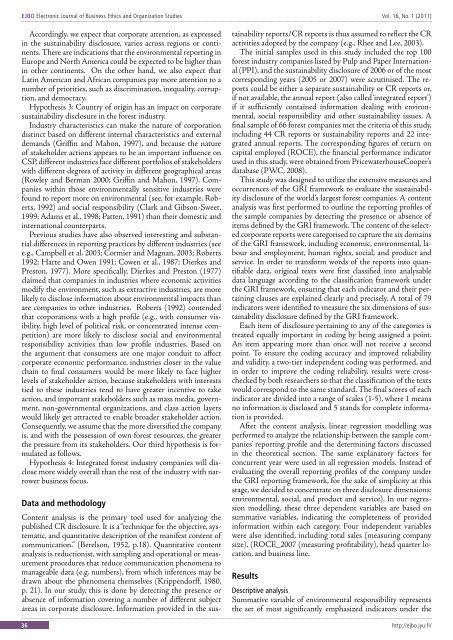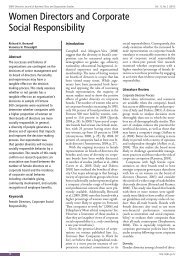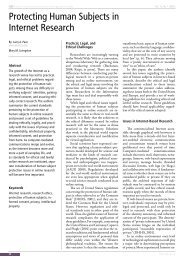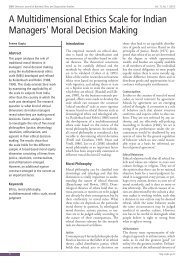View PDF - Electronic Journal of Business Ethics and Organization ...
View PDF - Electronic Journal of Business Ethics and Organization ...
View PDF - Electronic Journal of Business Ethics and Organization ...
- TAGS
- electronic
- ethics
- ejbo.jyu.fi
You also want an ePaper? Increase the reach of your titles
YUMPU automatically turns print PDFs into web optimized ePapers that Google loves.
EJBO <strong>Electronic</strong> <strong>Journal</strong> <strong>of</strong> <strong>Business</strong> <strong>Ethics</strong> <strong>and</strong> <strong>Organization</strong> Studies Vol. 16, No. 1 (2011)<br />
Accordingly, we expect that corporate attention, as expressed<br />
in the sustainability disclosure, varies across regions or continents.<br />
There are indications that the environmental reporting in<br />
Europe <strong>and</strong> North America could be expected to be higher than<br />
in other continents. On the other h<strong>and</strong>, we also expect that<br />
Latin American <strong>and</strong> African companies pay more attention to a<br />
number <strong>of</strong> priorities, such as discrimination, inequality, corruption,<br />
<strong>and</strong> democracy.<br />
Hypothesis 3: Country <strong>of</strong> origin has an impact on corporate<br />
sustainability disclosure in the forest industry.<br />
Industry characteristics can make the nature <strong>of</strong> corporation<br />
distinct based on different internal characteristics <strong>and</strong> external<br />
dem<strong>and</strong>s (Griffin <strong>and</strong> Mahon, 1997), <strong>and</strong> because the nature<br />
<strong>of</strong> stakeholder actions appears to be an important influence on<br />
CSP, different industries face different portfolios <strong>of</strong> stakeholders<br />
with different degrees <strong>of</strong> activity in different geographical areas<br />
(Rowley <strong>and</strong> Berman 2000; Griffin <strong>and</strong> Mahon, 1997). Companies<br />
within those environmentally sensitive industries were<br />
found to report more on environmental (see, for example, Roberts,<br />
1992) <strong>and</strong> social responsibility (Clark <strong>and</strong> Gibson-Sweet,<br />
1999; Adams et al., 1998; Patten, 1991) than their domestic <strong>and</strong><br />
international counterparts.<br />
Previous studies have also observed interesting <strong>and</strong> substantial<br />
differences in reporting practices by different industries (see<br />
e.g., Campbell et al. 2003; Cormier <strong>and</strong> Magnan, 2003; Roberts<br />
1992; Harte <strong>and</strong> Owen 1991; Cowen et al., 1987; Dierkes <strong>and</strong><br />
Preston, 1977). More specifically, Dierkes <strong>and</strong> Preston (1977)<br />
claimed that companies in industries where economic activities<br />
modify the environment, such as extractive industries, are more<br />
likely to disclose information about environmental impacts than<br />
are companies in other industries. Roberts (1992) contended<br />
that corporations with a high pr<strong>of</strong>ile (e.g., with consumer visibility,<br />
high level <strong>of</strong> political risk, or concentrated intense competition)<br />
are more likely to disclose social <strong>and</strong> environmental<br />
responsibility activities than low pr<strong>of</strong>ile industries. Based on<br />
the argument that consumers are one major conduit to affect<br />
corporate economic performance, industries closer in the value<br />
chain to final consumers would be more likely to face higher<br />
levels <strong>of</strong> stakeholder action, because stakeholders with interests<br />
tied to these industries tend to have greater incentive to take<br />
action, <strong>and</strong> important stakeholders such as mass media, government,<br />
non-governmental organizations, <strong>and</strong> class action layers<br />
would likely get attracted to enable broader stakeholder action.<br />
Consequently, we assume that the more diversified the company<br />
is, <strong>and</strong> with the possession <strong>of</strong> own forest resources, the greater<br />
the pressure from its stakeholders. Our third hypothesis is formulated<br />
as follows.<br />
Hypothesis 4: Integrated forest industry companies will disclose<br />
more widely overall than the rest <strong>of</strong> the industry with narrower<br />
business focus.<br />
Data <strong>and</strong> methodology<br />
Content analysis is the primary tool used for analyzing the<br />
published CR disclosure. It is a “technique for the objective, systematic,<br />
<strong>and</strong> quantitative description <strong>of</strong> the manifest content <strong>of</strong><br />
communication.” (Berelson, 1952, p.18). Quantitative content<br />
analysis is reductionist, with sampling <strong>and</strong> operational or measurement<br />
procedures that reduce communication phenomena to<br />
manageable data (e.g. numbers), from which inferences may be<br />
drawn about the phenomena themselves (Krippendorff, 1980,<br />
p. 21). In our study, this is done by detecting the presence or<br />
absence <strong>of</strong> information covering a number <strong>of</strong> different subject<br />
areas in corporate disclosure. Information provided in the sus-<br />
tainability reports/CR reports is thus assumed to reflect the CR<br />
activities adopted by the company (e.g., Rhee <strong>and</strong> Lee, 2003).<br />
The initial samples used in this study included the top 100<br />
forest industry companies listed by Pulp <strong>and</strong> Paper International<br />
(PPI), <strong>and</strong> the sustainability disclosure <strong>of</strong> 2006 or <strong>of</strong> the most<br />
corresponding years (2005 or 2007) were scrutinised. The reports<br />
could be either a separate sustainability or CR reports or,<br />
if not available, the annual report (also called ‘integrated report’)<br />
if it sufficiently contained information dealing with environmental,<br />
social responsibility <strong>and</strong> other sustainability issues. A<br />
final sample <strong>of</strong> 66 forest companies met the criteria <strong>of</strong> this study,<br />
including 44 CR reports or sustainability reports <strong>and</strong> 22 integrated<br />
annual reports. The corresponding figures <strong>of</strong> return on<br />
capital employed (ROCE), the financial performance indicator<br />
used in this study, were obtained from PricewaterhouseCooper’s<br />
database (PWC, 2008).<br />
This study was designed to utilize the extensive measures <strong>and</strong><br />
occurrences <strong>of</strong> the GRI framework to evaluate the sustainability<br />
disclosure <strong>of</strong> the world’s largest forest companies. A content<br />
analysis was first performed to outline the reporting pr<strong>of</strong>iles <strong>of</strong><br />
the sample companies by detecting the presence or absence <strong>of</strong><br />
items defined by the GRI framework. The content <strong>of</strong> the selected<br />
corporate reports were categorised to capture the six domains<br />
<strong>of</strong> the GRI framework, including economic, environmental, labour<br />
<strong>and</strong> employment, human rights, social, <strong>and</strong> product <strong>and</strong><br />
service. In order to transform words <strong>of</strong> the reports into quantifiable<br />
data, original texts were first classified into analysable<br />
data language according to the classification framework under<br />
the GRI framework, ensuring that each indicator <strong>and</strong> their pertaining<br />
clauses are explained clearly <strong>and</strong> precisely. A total <strong>of</strong> 79<br />
indicators were identified to measure the six dimensions <strong>of</strong> sustainability<br />
disclosure defined by the GRI framework.<br />
Each item <strong>of</strong> disclosure pertaining to any <strong>of</strong> the categories is<br />
treated equally important in coding by being assigned a point.<br />
An item appearing more than once will not receive a second<br />
point. To ensure the coding accuracy <strong>and</strong> improved reliability<br />
<strong>and</strong> validity, a two-tier independent coding was performed, <strong>and</strong><br />
in order to improve the coding reliability, results were crosschecked<br />
by both researchers so that the classification <strong>of</strong> the texts<br />
would correspond to the same st<strong>and</strong>ard. The final scores <strong>of</strong> each<br />
indicator are divided into a range <strong>of</strong> scales (1-5), where 1 means<br />
no information is disclosed <strong>and</strong> 5 st<strong>and</strong>s for complete information<br />
is provided.<br />
After the content analysis, linear regression modelling was<br />
performed to analyze the relationship between the sample companies’<br />
reporting pr<strong>of</strong>ile <strong>and</strong> the determining factors discussed<br />
in the theoretical section. The same explanatory factors for<br />
concurrent year were used in all regression models. Instead <strong>of</strong><br />
evaluating the overall reporting pr<strong>of</strong>iles <strong>of</strong> the company under<br />
the GRI reporting framework, for the sake <strong>of</strong> simplicity at this<br />
stage, we decided to concentrate on three disclosure dimensions:<br />
environmental, social, <strong>and</strong> product <strong>and</strong> service). In our regression<br />
modelling, these three dependent variables are based on<br />
summative variables, indicating the completeness <strong>of</strong> provided<br />
information within each category. Four independent variables<br />
were also identified, including total sales (measuring company<br />
size), (ROCE_2007 (measuring pr<strong>of</strong>itability), head quarter location,<br />
<strong>and</strong> business line.<br />
Results<br />
Descriptive analysis<br />
Summative variable <strong>of</strong> environmental responsibility represents<br />
the set <strong>of</strong> most significantly emphasized indicators under the<br />
36 http://ejbo.jyu.fi/











